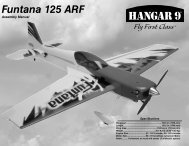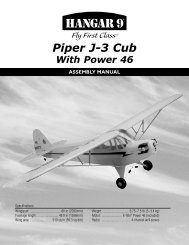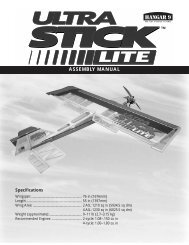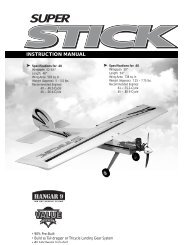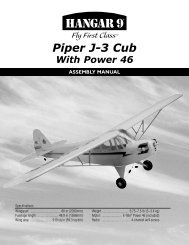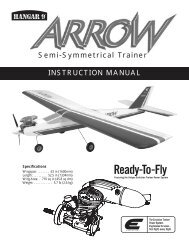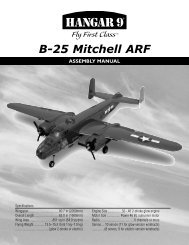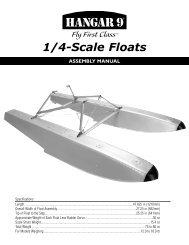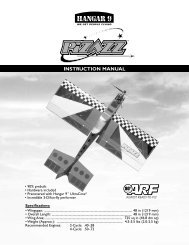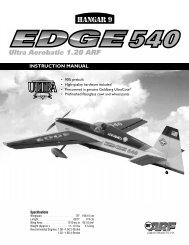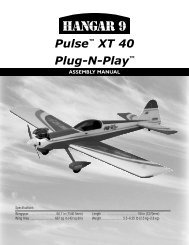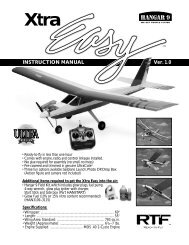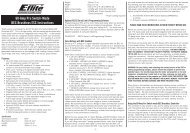You also want an ePaper? Increase the reach of your titles
YUMPU automatically turns print PDFs into web optimized ePapers that Google loves.
PreflightFor those of you who are veterans of large models, thisis old news. But to you newcomers to the world of largemodels, this is very important information.While many smaller models are not critical of properbattery use, and are tolerant of improper control linkagesetups and flying techniques, large models are not. Don’tlet that scare you away from large models; they are trulyone of the best flying experiences in RC that moneycan buy. However, please pay particular attention to thefollowing areas.Maintain the proper mechanical advantage on allcontrol surface linkages.Just as with unsealed hinge gaps, mechanical advantageis often another cause of flutter. Please follow the controlhorn and servo arm lengths recommended in this manual.Shorter arms on the servo or longer control horns on theelevator and ailerons are fine, but do not try to go theother way to increase throw. It can cause flutter or servofailure on the <strong>Extra</strong> <strong>260</strong>. The recommended linkage setupsare more than adequate to achieve full 3D throws.Check the radio installation and make sure all thecontrol surfaces are moving correctly (i.e. the correctdirection and with the recommended throws). Testrun the engine and make sure it transitions smoothlyfrom idle to full throttle and back. Also ensure theengine is tuned according to the manufacturer’sinstructions, and it will run consistently and constantlyat full throttle when adjusted.Check all the control horns, servo horns, and clevises tomake sure they are secure and in good condition. Replaceany items that would be considered questionable. Failureof any of these components in flight would mean the lossof your aircraft.While many smaller models are very tolerant of impropercontrol linkage setups and flying techniques, large modelsare not. Don’t let that scare you away from large models;they are truly one of the best flying experiences in RC thatmoney can buy. However, please pay particular attention tothe following areas.Never attempt to make full throttle dives!Large models perform much more like full-size aircraftthan small models. If the airframe goes too fast, such asin a high throttle dive, it may fail. The <strong>Extra</strong> <strong>260</strong> should beflown like a full-scale <strong>Extra</strong> <strong>260</strong>. Throttle management isabsolutely necessary.Hardware checksDouble-check the setscrews in all contol horns to be surethey are very tight. Periodically check these to be surethey have not loosened over time. Always use threadlockon metal-to-metal fasteners.Receiver Battery SelectionBe sure adequate batteries are used to power the receiver.It is STRONGLY recommended that two identical 6-voltreceiver packs are used. Each pack must have a minimumof 2700mAh capacity. Use packs of 3000mAh when superhigh torque servos are used.Servo selectionBe sure all servos used on elevator, aileron and rudder aremetal geared type and have at least 188 oz in of torque.Failure to do this will very likely result in a failure andloss of the model.Range checkAlways range check the radio system per themanufacturer's instructions before the initial test flight andperiodically afterward.Check the voltage of the on-board packsALWAYS use an ESV with a 1-amp load to check thereceiver battery packs and the ignition pack before eachand every flight. If there is any doubt that the packs arequestionable, DO NOT FLY until the packs are recharged.36



